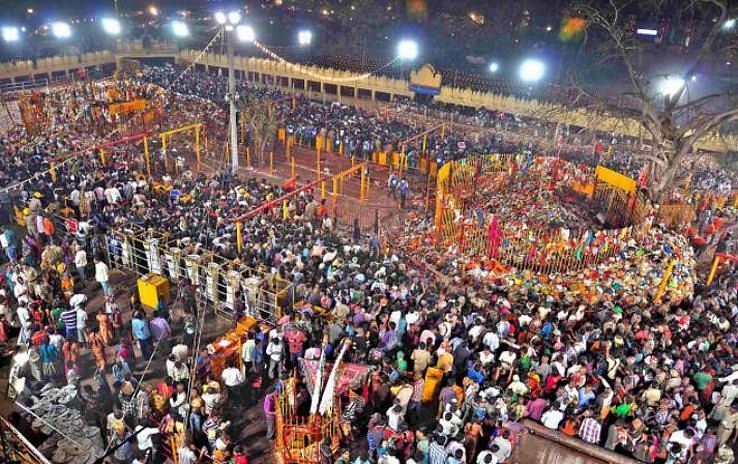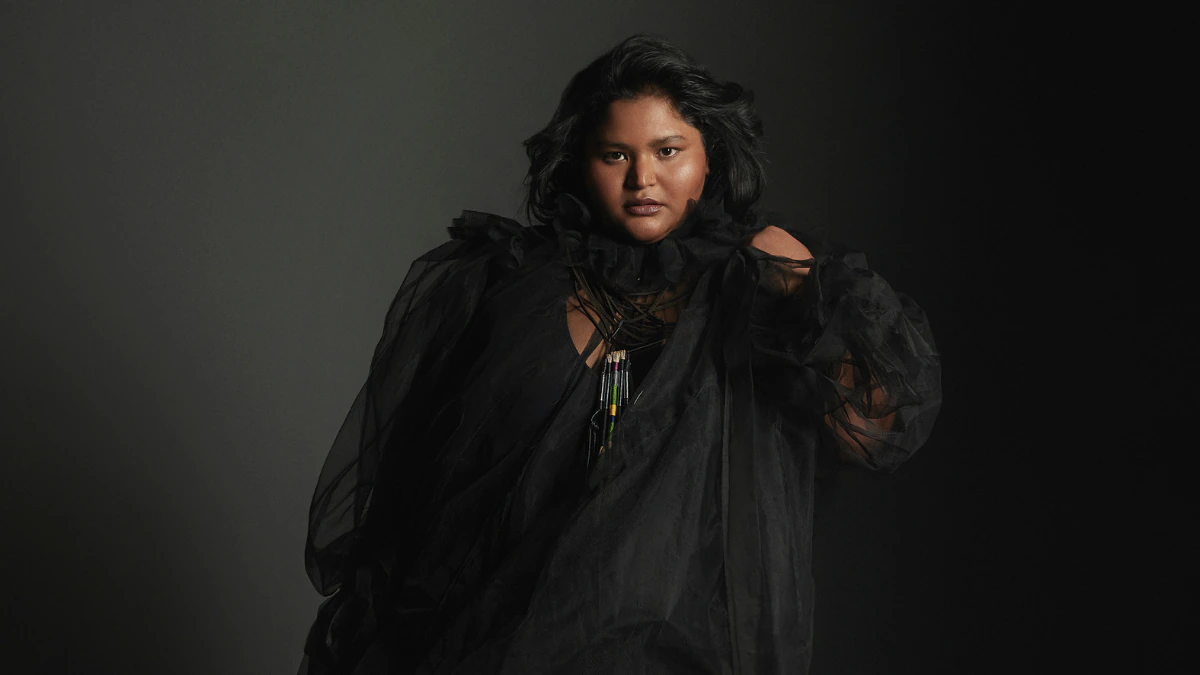Every two years, on the day of Sudha Pouranami, the Adivasis and the Dalits of Telangana congregate at the people’s fair in Medaram. The fair, also called Medaram Jana Jatara, is said by many to be one of the largest gatherings of people in the world. Over four days starting on a full moon, usually between February 5 and 8, some 1.3 crore people throng to the village to commemorate the martyrdom of Sammaka and Sarlamma in their battle against the Kakatiya Dynasty. But many have not read about it or heard of it, and that’s because the Medaram Jana Jatara potrays what one might call a “parallel” culture, a popular tribal festival whose existence is not acknowledged by the hegemonic brahmanical order.
The The Medaram Jana Jaatara has significant importance for us in our contemporary times. As waves of protests led by women reverberate through the country, a four-day carnival, which celebrates women’s valour in another era, might tell us something interesting about the revolutionary appeal of women resistance across history.
The festival is fast losing its unique identity, and in a sense, is being co-opted by the dominant practice of Hindu rituals.
However, The Medaram Jana Jatara is slowly being threatened by the process of sanskritization by the Hindutva forces. The festival is fast losing its unique identity, and in a sense, is being co-opted by the dominant practice of Hindu rituals. It is in this context of Hinduisation of local cultures that one should understand the longer history of the Adivasis of Telangana, and importance of the battle of Sammakka and Sarlamma against the Pratapa Rudra of the Kakatiya Dynasty.
Also Read: India’s Brahminical Idea Of Development Excludes Its Tribal Communities
The History of Medaram Jan Jatara (People’s Fair)
The story dates back to the Kakatiya Dynasty of Orugallu in present Telangana state. The Kakatiya dynasty lasted between 1000AD to 1380AD, a dynasty which has produced warriors of the likes of queen, Rani Rudramadevi. It is during the period of Pratapa Rudra, that the kingdom of Bhupalapatnam (A Koya kingdom. Koya is an Adivasi community that has a significant presence in the states of Andhra Pradesh, Chattisgarh, and Telangana), a tributary province, was made to pay taxes for being a tributary province of Kakatiyas.
The chieftain of the tributary province Bhupalapatnam adopted a little girl-child who was found in the forest and named her Sammakka. As per Adivasi legends and oral-narratives, Sammakka was found playing with Tigers in the forest. When she came of age, Sammakka was married to Padigidda Raju who was the son of the chieftain of Kottapalli in the present Bastar district of Chattisgarh. He was also the nephew of Meda Raju – II (1116A.D. – 1158 A.D.), the ruler of Karinagar’s Polavasa kingdom.
Padigiddaraju later became the chieftain of Medaram in the same district. Pratapa Rudra declared a battle with his tributary state’s as they did not pay taxes. It was a period of drought that worst affected the provinces of Medaram, Polasa ,and Bhupalalpatnam, along with other tributary provinces ruled by other indigenous rulers. After losing to Pratapa, the families of Meda Raju and Padigidda Raju with their people had to migrate to present Warangal’s Medaram-Bayykkapeta forests from their previous kingdom after losing in a battle with Pratapa Rudra in 1159A.D. They formed a new mini kingdom at their new place Medaram at Bayyakka forests in Warangal. Sammakka gave birth to another fierce warrior woman named Sarakka or Saralamma. The couple, Sammakka and Padigidda Raju, also had a male child named Jampanna.
The life at their new place was going well for both the families. However, upon learning about the formation of a new enemy kingdom, the Kakatiya’s Pratapa Rudra invaded the present Medaram. In a fierce confrontation with the Pratapa Rudra’s army, Jampanna died near the lake. The Jampanna Lake in Medaram was named after him. In the battle that lasted for a fortnight, Sammakka and Sarakka used strategies that have a resemblance to Guerilla Warfare. With a few people at their side, the mother-daughter duo took down a large portion of the Kakatiya army. After losing the battle, it is believed that the mother-daughter duo disappeared into the forest.
Oral Narratives of the Indigenous People
So what is the story of Sammakka and Saralamma? There was a severe drought that lasted for years and as a result, the mighty Godavari River dried up. The Koya kingdom was hit by hunger and famine. However, the Kakatiya’s insisted on the payment of taxes. Upon learning of the Koya chieftain’s refusal to pay the taxes, the Kaktiya emperor sent his forces to teach the Adivasis a lesson. In the battle against Kakatiya’s, most of the Koya chiefdoms had fallen.
After the bitter war, the Kakatiya Prime Minister visited the war-ravaged Adivasi chiefdoms and provinces and proposed a peace accord and offered Sammakka a place in the empire’s harem as the chief queen by wedding Sarakka to Pratapa Rudra. Sammakka turned down the offer and resolved to continue the fight to avenge the dead. The battle continued and Sammakka was wounded. Sammakka told her people that as long as they remember her, she would protect them. Then, she cursed the Kakatiya dynasty to perish and disappeared into the deep forest.
Adivasis searched for their queen and found only a red ochre box, her bangles and the pug-marks of a tigress. Sometime after this, the Muslim invaders destroyed the Kakatiya dynasty. Since then, it has been believed that the Koyas, Waddaras (a Dalit community), other Adivasi communities, mainland tribes, and lower caste groups have been holding festivals in the memory of Sammakka and Sarakka regularly.
The Ritual Procedure
The ritual practices of The Medaram Jana Jaatara are fascinating. For one, there is no permanent idol of the deity. The ritual to summon the goddesses involves a Koya boy whose kinship can be traced back to Sammakka and her daughter gets a vision before the festival, searches in the forest for a week through a sacred procedure of Upavasa. He brings the goddesses in the form of two vermillion caskets tied to a piece of bamboo, one representing the main deity Sammakka and the other, her daughter Saralamma. Saralamma would be traditionally bought from Kanneboyinpalle hamlet, and installed at an earthen platform raised under a tree.
The Medaram Jana Jaatara tells us that the deities of Indigenous masses and the oppressed social groups have nothing in common with Hinduism and Hindutva propaganda mechanism.
During the festival, many animals are sacrificed and intoxicants such as liquor are widely consumed. Hundreds of people who are often possessed by the goddess come there dancing ecstatically throughout the journey. The special offerings to the deity are jaggery. Some offer jaggery equal to their weight and distribute it among the masses. Sometimes, even though it’s rare, one gets the opportunity to witness primitive worshipping practices such as Pabba, Siva-Satti, and Lakshmi Devaras, which are considered by many to be lost practices.
Also Read: The Tale Of Mahishasur And Durga: The Missing Story Of The Tribal Hero
Conclusion
The Medaram Jana Jaatara, then, gives us the following inferences. Firstly, it tells us that the deities of Indigenous masses and the oppressed social groups have nothing in common with Hinduism and Hindutva propaganda mechanism. Secondly, it tells us that the practices of worship and rituals of these social groups too are entirely different from caste-Hindus, and in many ways is better for the devotees, as it doesn’t burden them with any major costs. Essentially these deities of the oppressed groups aren’t accepted by caste-Hindus. However, the Devadaya Shakha (The temple related department under the govt. of Telangana) makes huge wealth through intervening in the affairs and rituals of the oppressed masses in places like Medaram during the occasion of the Fair.
References
- Sri Sammakka- Saralamma Jatara by Govt. of Telangana
- Sammakka-Sarakka Porata Gaatha by Bhupati Venkateshwarlu (2017)
- The Hindu
Feature Image Source:
About the author(s)
I am an education professional who has experience working in NGOs and schools involved in the task of improving school education and ensuring social equity in the academic sector, presently teaching as teacher educator in college. I am a graduate in social sciences, with an interest in teaching students at the secondary school level. My latest research interest is looking at the intersection of gender and caste in schools and on education overall.




